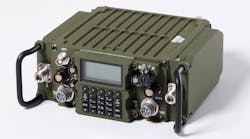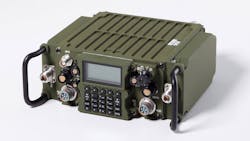Heightened security requirements are part of the newest tactical radios, and Rockwell Collins has done its part in establishing the reliability and security of the AN/PRC-162(V)1 software-defined radio (SDR) for military ground use. The versatile tactical radio has passed testing to meet the security requirements for the DoD’s final version of the Mobile User Objective System (MUOS). The testing was performed by the U.S. Navy Space and Naval Warfare Systems Command (SPAWAR) using the most current version of the MUOS waveform.
The AN/PRC-162(V)1 (see figure) joins Rockwell-Collins’ recent successful testing of the first airborne VHF/UHF radio to pass the MUOS test, known by its “do not harm” (DNH) nickname. “MUOS will provide the warfighter with more mobility, improved signal quality and availability, which is especially important for units on the ground if they’re operating in rough terrain or communicating beyond line of sight,” said Troy Brunk, vice president and general manager of communication, navigation, and electronic warfare solutions for Rockwell Collins. “We understand how critical MUOS is to the future success of our armed forces and we’ll continue to lead the development of this technology both for use in the air and on the ground.”
The AN/PRC-162(V)1 tactical radio uses SDR technology to meet the critical MUOS security requirements of ground-based military radios. (Courtesy of Rockwell Collins).
MUOS is a secure, high-speed IP-based system designed to provide military voice, video, and mission data. It provides an improvement over current UHF satellite-communications (satcom) systems and will also provide a connection with the Global Information Grid and into the Defense Switched Network. It has been tested for its capability to provide Integrated Broadcast Service (IBS) messaging and has survived operation in Arctic environments, to 89.5° North latitude.


